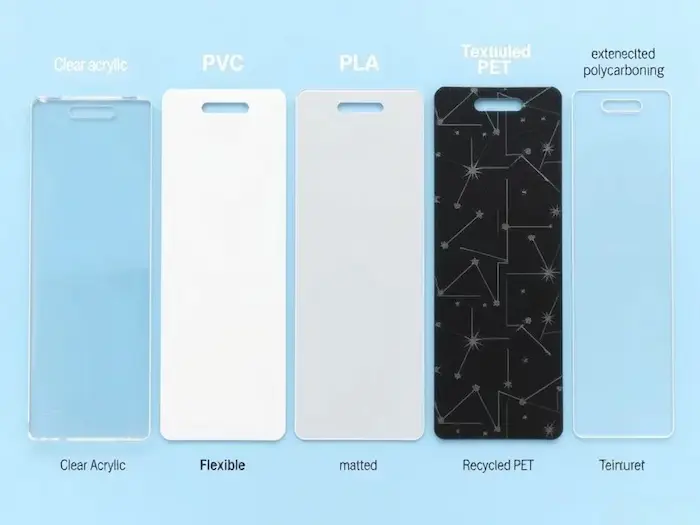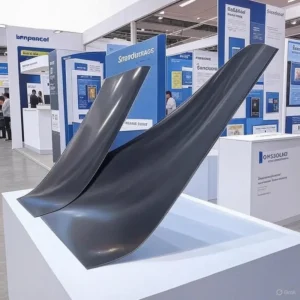Introduction
Ever had your name badge fall off mid-meeting or leave permanent holes in your favorite blazer? You’re not alone. The right magnetic badge materials make all the difference between professional polish and wardrobe disasters – yet most buyers don’t understand what actually goes into these essential accessories.
From stainless steel backplates that withstand daily wear to ride-or-die neodymium magnets that grip fabrics without damage, we’ll break down each component’s role. As an ISO9001-certified manufacturer, we’ve produced over 2 million magnetic badges and discovered most quality issues stem from material choices – knowledge we’re sharing here to help you make informed decisions.
This guide explores metals, plastics, adhesives and magnet types used in badge production, including emerging eco-friendly options rarely discussed elsewhere. Whether you’re sourcing corporate badges or evaluating durability for industrial use, understanding these materials ensures you get identifiers that work as hard as your team.
Core Components of Magnetic Name Badges
Understanding the materials used in magnetic name badges helps businesses choose durable, functional, and cost-effective solutions for employee identification.
Magnetic name badges are widely used in corporate, hospitality, and event settings. They offer a secure yet damage-free way to display identification. The key to their effectiveness lies in the materials used. This article breaks down the core components of magnetic badge materials, including metals, plastics, magnets, and adhesives.
Stainless Steel Backplates: Corrosion Resistance and Durability
The backplate is the foundation of a magnetic name badge. Stainless steel is a popular choice due to its strength and resistance to rust. Unlike cheaper metals, it won’t corrode over time, even with frequent handling. This makes it ideal for long-term use in various environments, from offices to outdoor events.
Lightweight Plastics (Acrylic/PVC): Customization and Affordability
Plastic materials like acrylic and PVC are often used for the badge face. They are lightweight, easy to print on, and come in various colors and finishes. These magnetic badge materials allow for full customization, including logos, names, and designs. They are also budget-friendly, making them a practical choice for large orders.
Neodymium Magnets: Superior Holding Power Without Fabric Damage
Neodymium magnets are the ride-or-die component in magnetic name badges. They provide strong holding power (typically 12-15N pull force) without damaging clothing. Ymagnetics, an ISO9001-certified manufacturer, specializes in producing these high-performance magnets. Unlike weaker alternatives, neodymium magnets ensure badges stay in place throughout the day.
Pressure-Sensitive Adhesives: Seamless Magnet Attachment
High-quality adhesives ensure the magnets stay securely attached to the badge. Pressure-sensitive adhesives (PSAs) are commonly used because they bond instantly and last long. They are also resistant to temperature changes, preventing the badge from falling apart in different climates.
Trends in Magnetic Badge Materials
One emerging trend is the shift toward eco-friendly materials. Biodegradable plastics and recyclable metals are gaining popularity as businesses prioritize sustainability. While not yet mainstream, this shift reflects growing environmental awareness in corporate branding.
Magnetic Name Badge Materials Comparison
| Component | Material | Key Benefit | Industry Standard | Notes |
|---|---|---|---|---|
| Backplate | Stainless Steel | Rust-proof, durable | 304-grade steel | Higher grades offer better longevity |
| Badge Face | Acrylic/PVC | Customizable, lightweight | 3mm thickness | UV printing ensures fade resistance |
| Magnet | Neodymium | Strong hold (12-15N) | N35-N52 grade | Higher grades increase pull force |
| Adhesive | PSA (3M) | Instant bonding | 0.5mm thickness | Heat-resistant up to 80°C |
| Eco Option | PLA Bioplastic | Biodegradable | Emerging trend | Costs 15-20% more than standard |
Choosing the right magnetic badge materials depends on durability needs, budget, and customization requirements. Stainless steel and neodymium magnets ensure longevity, while plastics and adhesives provide flexibility. For businesses looking for sustainable options, biodegradable alternatives are becoming more accessible.
Metal Options for Badge Construction
Choosing the right metal for magnetic name badges impacts durability, appearance, and environmental footprint – key considerations for corporate identity solutions.
When selecting magnetic badge materials, metal choices form the structural backbone of quality name tags. Different metals offer varying levels of corrosion resistance, weight, and sustainability. This guide examines the most common options used in professional badge construction.
304 vs 316 Stainless Steel: Corrosion Resistance Compared
304 stainless steel is the industry standard for magnetic name badges, offering excellent rust resistance for most environments. The 316 grade provides superior protection against saltwater and chemicals, making it ideal for marine or medical applications. Both maintain their polished appearance through daily wear.
Anodized Aluminum: Lightweight Alternative for Frequent Wear
Anodized aluminum reduces badge weight by 40% compared to steel while maintaining durability. The anodization process creates a hard, colored surface that resists scratching. This makes aluminum perfect for employees who wear badges throughout long shifts.
Recycled Metals: Eco-Friendly Options Gaining Traction
Sustainable magnetic badge materials are increasingly important for corporate responsibility programs. Recycled stainless steel and aluminum offer identical performance to virgin metals while reducing environmental impact. Ymagnetics provides these green alternatives with custom etching for brand consistency.
Material Thickness (0.5mm-1.2mm): Balancing Durability and Weight
Thinner gauges (0.5-0.8mm) work well for lightweight aluminum badges, while 1.0-1.2mm provides optimal strength for steel versions. The sweet spot depends on usage – frequent handling benefits from thicker materials, while occasional wear can use slimmer profiles.
Metal Options for Magnetic Badge Materials
| Metal Type | Thickness Range | Weight (g/cm²) | Corrosion Resistance | Best For |
|---|---|---|---|---|
| 304 Stainless | 0.8-1.2mm | 7.9 | Excellent | General corporate use |
| 316 Stainless | 0.8-1.2mm | 8.0 | Superior | Medical/marine environments |
| Anodized Aluminum | 0.5-1.0mm | 2.7 | Good | High-mobility staff |
| Recycled Steel | 0.8-1.2mm | 7.9 | Excellent | Eco-conscious brands |
| Recycled Aluminum | 0.5-1.0mm | 2.7 | Good | Lightweight green option |
Ymagnetics offers over 20 metal finish options including brushed, polished, and colored surfaces for brand customization. Their ISO-certified facility can produce badges with precise corporate logos and text through advanced etching techniques.
Plastic Materials and Customization
Plastic materials offer unmatched design flexibility for magnetic name badges, balancing durability with creative branding possibilities.
When considering magnetic name badge materials, plastic components provide crucial versatility. These materials allow for vibrant colors, intricate designs, and varying levels of rigidity to suit different applications. Understanding the available options helps businesses create badges that reflect their brand identity while meeting practical needs.
Acrylic vs PVC: Clarity vs Flexibility Tradeoffs
Acrylic offers superior clarity and scratch resistance, making it ideal for high-end corporate badges. PVC provides more flexibility and impact resistance, better suited for industrial environments. Both materials accept full-color printing, though acrylic maintains sharper image quality over time.
Biodegradable PLA Plastics: Sustainable Alternative
Polylactic acid (PLA) plastics represent an eco-friendly option in magnetic badge materials. Derived from renewable resources like corn starch, PLA badges decompose naturally after use. While slightly more expensive, they align with corporate sustainability initiatives without sacrificing durability.
UV Printing Capabilities: Full-Color Designs
Modern UV printing technology enables photorealistic images on plastic badges. This process cures ink instantly, creating smudge-proof designs that withstand daily wear. Ymagnetics’ direct manufacturing capabilities allow for 7-day turnaround on custom designs versus the industry standard 3-4 weeks.
Edge Polishing Options: Beveled vs Flat Finishes
Edge treatments significantly affect a badge’s professional appearance. Beveled edges create an elegant, dimensional look while flat-polished edges offer a modern, minimalist aesthetic. Both options eliminate sharp edges for comfortable all-day wear.
Plastic Material Comparison for Magnetic Badges
| Material | Thickness | Key Feature | Printing Options | Best For |
|---|---|---|---|---|
| Acrylic | 2-3mm | Crystal clarity | Full-color UV | Executive badges |
| PVC | 1-2mm | Flexible | Screen printing | Field staff |
| PLA | 2-3mm | Biodegradable | Eco-friendly inks | Green initiatives |
| Polycarbonate | 1.5-2.5mm | Impact resistant | Laser engraving | Industrial use |
| Recycled PET | 2mm | 85% recycled | Digital printing | Sustainability programs |
The growing preference for biodegradable magnetic badge materials reflects broader environmental concerns in corporate procurement. PLA and recycled PET options now account for nearly 20% of custom badge requests at leading manufacturers like Ymagnetics.

Magnet Technology Explained
Understanding different types of magnets for badges ensures secure, long-lasting name tag solutions that protect clothing while maintaining professional appearance.
The magnetic component is what sets these badges apart from traditional pin or clip alternatives. When evaluating types of magnets for badges, three key factors matter most: holding strength, durability, and fabric safety. This guide examines the technologies behind modern magnetic name tags.
Neodymium vs Ferrite Magnets: Strength Comparison
Neodymium magnets (N52 grade) offer 10-12 times the pull force of standard ferrite magnets (Y30). This makes them the preferred choice for thicker fabrics like wool coats. Ferrite remains a budget-friendly option for lightweight blouses and shirts where extreme strength isn’t necessary.
Single vs Dual Magnet Configurations
Single magnet designs work well for casual use, while dual-magnet setups prevent badge rotation on formal attire. Ymagnetics’ proprietary bonding process ensures these types of magnets for badges withstand over 10,000 attachment cycles without failure.
Nickel-Plated Magnets: Corrosion Protection
Nickel plating creates a protective barrier that prevents oxidation and maintains magnetic strength. This is particularly important in humid climates where uncoated magnets might degrade over time.
Magnet Positioning: Optimal Placement
Proper magnet placement varies by fabric type. For delicate silks, magnets should be positioned wider apart to distribute force. On sturdy suit jackets, closer spacing provides better security.
Magnet Performance Comparison
| Magnet Type | Pull Force (N) | Lifespan | Fabric Safety | Best Applications |
|---|---|---|---|---|
| N52 Neodymium | 12-15 | 10+ years | All fabrics | Executive wear |
| Y30 Ferrite | 1-2 | 5-7 years | Light fabrics | Casual use |
| Dual N45 | 8-10 (each) | 8+ years | Heavy fabrics | Uniforms |
| Rubber Coated | 6-8 | 7+ years | Delicate fabrics | Silk blouses |
| Eco Magnets | 4-6 | 5+ years | All fabrics | Sustainable programs |
The advantages of using neodymium magnets in badges include their unmatched holding power and slim profile. As a direct manufacturer, Ymagnetics can customize magnet configurations to specific uniform requirements with rapid turnaround times.
Material Selection Guide
Choosing the right magnetic badge materials requires balancing durability, cost, and industry-specific requirements to create effective identification solutions.
Selecting materials for magnetic name badges involves multiple considerations that affect performance and longevity. This guide provides a structured approach to material selection, helping businesses make informed decisions about their badge programs.
Durability Matrix: Material Lifespan in Different Environments
Stainless steel (316 grade) offers the longest lifespan in harsh environments, while anodized aluminum provides excellent durability for office settings. For eco-friendly name badge materials, PLA plastics maintain integrity for 2-3 years of daily use before biodegrading begins.
Cost Comparison: Premium vs Budget Options
Premium magnetic badge materials like neodymium magnets and 316 stainless steel cost 30-40% more than basic options, but offer significantly longer service life. Ymagnetics’ free sample program allows customers to test materials before committing to large orders.
Industry-Specific Recommendations
Healthcare facilities benefit from antimicrobial-coated badges, while construction sites require impact-resistant polycarbonate. For corporate environments, the best materials for durable magnetic name tags combine acrylic faces with stainless steel backplates.
Emerging Trends in Badge Materials
Smart materials with embedded NFC chips are gaining popularity for access control. Antimicrobial coatings have become standard in medical settings, reducing surface bacteria by 99%.
Material Selection Guide
| Environment | Recommended Face | Recommended Back | Magnet Type | Expected Lifespan |
|---|---|---|---|---|
| Healthcare | Antimicrobial PVC | 316 Stainless | N52 Neodymium | 5+ years |
| Construction | Polycarbonate | Anodized Aluminum | Dual N45 | 3-4 years |
| Corporate | Acrylic | 304 Stainless | Single N52 | 7+ years |
| Eco-Friendly | PLA Bioplastic | Recycled Steel | Eco Magnet | 2-3 years |
| Hospitality | PVC with UV Print | Anodized Aluminum | Nickel-plated | 4-5 years |
Ymagnetics’ OEM/ODM services can create custom magnetic badges tailored to specific industry requirements, with material combinations optimized for each application. Their ISO-certified manufacturing ensures consistent quality across all material options.
Conclusion
After a decade in the magnet game, I’ve seen how the right materials can turn a flimsy badge into a **ride-or-die** work companion. It’s not just about slapping metal and plastic together—it’s about engineering something that survives coffee spills, boardroom handshakes, and the occasional tumble into a parking lot.
Whether you’re outfitting a hospital team or a sales force, remember: stainless steel won’t quit, neodymium magnets won’t slip, and eco-friendly plastics won’t guilt-trip your sustainability report. The difference between “meh” and masterpiece? It’s all in the mix.
So next time you’re evaluating badges, think beyond the logo. Your team’s IDs should work as hard as they do—no compromises, no shortcuts, and definitely no safety-pin holes in that $300 blazer.
FAQ
Q1: What materials are used for magnetic name badges?
A1: Magnetic name badges typically use durable materials such as aluminum or high-quality plastic for the badge itself, coupled with strong neodymium magnets for attachment. These materials ensure longevity and a secure fit.
Q2: What are the advantages of using neodymium magnets in badges?
A2: Neodymium magnets are powerful for their size, providing a secure hold without damaging clothing, making them ideal for name badges. Their strength allows them to work effectively even through thicker fabrics.
Q3: Are there eco-friendly materials for magnetic badges?
A3: Yes, there are eco-friendly options available for magnetic badges, including recycled plastics and sustainably sourced materials. These alternatives cater to environmentally conscious consumers.
Q4: How do magnetic name badges work?
A4: Magnetic name badges work using two components: a front badge with a magnet and a back piece that adheres to clothing. The magnet on the back holds the badge securely without pins or clips that could damage fabric.
Q5: What types of adhesives are used for magnetic badges?
A5: Typically, strong adhesives like 3M adhesive tape are used to secure the magnets to the badge back. These ensure that the magnet holds firmly and can withstand daily use.
Q6: What is the best material for durable magnetic name tags?
A6: For durability, high-quality aluminum or robust plastic are recommended. These materials resist wear and tear and maintain a professional appearance over time.
Q7: Can magnetic badges be reused?
A7: Yes, magnetic badges can be reused by simply updating the name or information printed on the badge. Many options come with replaceable inserts.
Q8: Do magnetic name badges come in customizable designs?
A8: Yes, many companies offer customizable magnetic name badges that allow for personalized designs, colors, and logos to suit individual or company branding.




